|
"The only known
Clovis-era site with Clovis type fluted points together with broken
mammoth limb-bones is Lange Ferguson."--------2002,
Gary Haynes, "The Early Settlement Of North America," p. 138.
"Lange Ferguson
provides new evidence, expanding our knowledge of Clovis disarticulation
and dismemberment strategies, through the recovery of heavy cleaving
tools and flakes produced on portions of mammoth scapulae and long bone
shaft elements in direct association with an event of mammoth butchering."--------1989,
L. Adrien Hannus, "Flaked Mammoth Bone From The Lange Ferguson Site
White River Badlands Area, South Dakota," Bone Modification, p.
395.
"The
three hypotheses (explaining the
presence of fractured limb bone and the bone flakes at mammoth sites)
are (1) large late Pleistocene carnivores caused the fractured limb
bones; (2) mammoth trampling fractured the limb bones; and (3) humans
wielding tools fractured the limb bones."----2005,
Steven R. Holen, "Taphonomy Of Two Last Glacial Maximum Mammoth
Sites In The Central Great Plains Of North America: A Preliminary Report
On La Sena And Lovewell," p. 36.
"Both animals (mammoths
on the Lange Ferguson site) were
butchered with bone tools that were fashioned from mammoth bone elements
during the butchering process."---------1990,
L. Adrien Hannus, "The Lange Ferguson Site: A Case For Mammoth
Bone-Butchering Tools," Megafauna & Man, Scientific Papers, Vol. 1,
p. 98.
"Lange Ferguson is one of less than thirty North
American localities where Clovis period human association with mammoths
is documented."------1990,
L. Adrien Hannus, "The Lange Ferguson Site: A Case For Mammoth
Bone-Butchering Tools," Megafauna & Man, Scientific Papers, Vol. 1,
p. 98.
"Dynamic loading points several centimeters in diameter
and bone flakes with bulbs of percussion and other features caused by
percussion are not documented from prehuman North American proboscidean
sites"----2005,
Steven R. Holen, "Taphonomy Of Two Last Glacial Maximum Mammoth
Sites In The Central Great Plains Of North America: A Preliminary Report
On La Sena And Lovewell," p. 41.

MAMMOTH BONE
BUTCHERING TOOLS
LANGE FERGUSON SITE
EST. 12,000 CALIBRATED YEARS
AGO
SOUTH DAKOTA
The earliest recorded use of bone tools in North
America is credited to the oldest recognized culture in North America,
the Clovis culture. Mammoth bone tools have been found on several kill
sites and cache sites in the western U.S. Some of these tools are well crafted, like the
bone wrench from the Murray Springs site, and were intended for
long term use. Other tools, like the examples illustrated in this
report, are crude in comparison and are sometimes referred to as tools
of expediency. The Clovis hunters, who either scavenged or killed the
mammoths on the Lange Ferguson site, left behind some of the best
examples of these types of tools. |
|
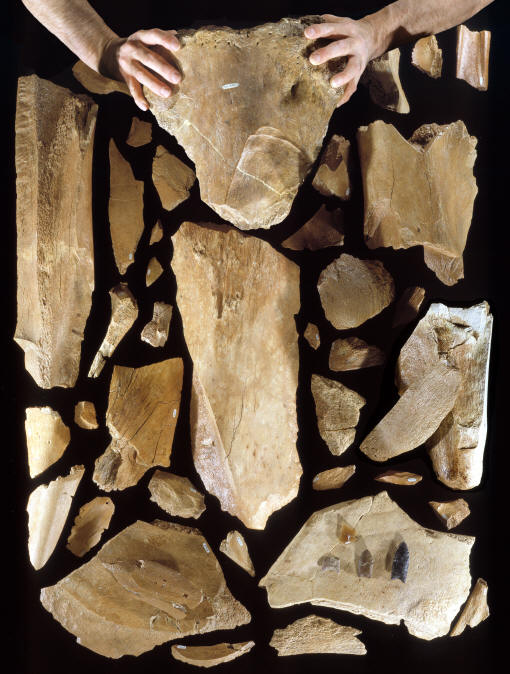
COLLECTION OF ARCHAEOLOGICAL LABORATORY,
CENTER FOR WESTERN STUDIES
AUGUSTANA COLLEGE
CLICK ON PICTURE FOR LARGER IMAGE
FRACTURED MAMMOTH BONES
LANGE FERGUSON SITE
SOUTH DAKOTA
This picture shows some of the
fractured mammoth bones and stone artifacts that were found on the
Lange Ferguson site. Some of these fractured bones, like the two
chopper/cleavers at top and lower center are believed to have been
used in the butchering process of two mammoths. Both of these
chopper/cleavers were made from the flat bone area from the same
right scapula of an adult mammoth. Both cleavers are described as
having some bifacial flaking. The edge of the longer cleaver was
bifacially flaked to form a sinuous edge. The longest cleaver
measures 17 15/16 inches (45.5 cm) long and weighs 7.28 pounds
(3,302.7). The heaviest cleaver at top
center measures 13 3/16 inches (33.5 cm) long and weighs 13.4 pounds
(6,088 grams).
The core at right edge center edge, with the long flake laying
against it, is one of five bone cores that were identified from the
site. This is no. 81-304 and it's one of the best examples that
shows evidence of platform preparation prior to the removal of the
large flake.
There were a total of four stone artifacts found on the Lange
Ferguson site. They are located on the large flat bone at lower
right. Two complete and one broken base of another Clovis point was
found within the excavation area. The fluted points were laying on
the bank of an ancient pond. The flake is made of semi-translucent
brown chalcedony. It was found in direct association with the
mammoth bones in the central bone bed concentration. It's believed
that the flake was removed from a biface. |
|
|
The Lange Ferguson site is one of the best preserved
Clovis kill sites ever discovered. The bones in the bone bed were almost
perfectly preserved, which is an indication the site was quickly buried
by slow moving sediments. None of the bones show any evidence of surface
weathering, rodent or carnivore gnawing or carbonate leaching. The bones
were also articulated in anatomical positions. |
|
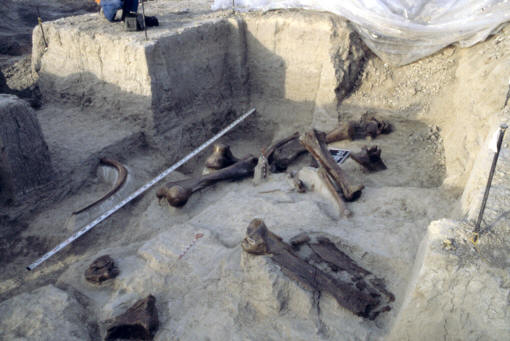
PICTURE
CREDIT--ARCHEOLOGY LABORATORY, CENTER FOR WESTERN STUDIES
AUGUSTANA
COLLEGE, DR. ADRIEN HANNUS
CLICK ON PICTURE FOR LARGER IMAGE
EXCAVATION OF MAMMOTH
BONES
MAIN BONE CONCENTRATION AREA
LANGE FERGUSON SITE
SOUTH DAKOTA
This picture was taken in 1980. It
shows the main bone concentration area on the Lange Ferguson mammoth
kill and butchering site. The bones of two mammoths, one adult and
one juvenile, were found in the excavation. The site is
located in the White River Badlands of South Dakota. Clovis kill
sites, although rare have been found across the united States. Most
of these sites are reported from west of the Mississippi River. |
|
|
Humans have been using bone as a raw material
for well over a million years. Its toughness, hardness and color are its
most desirable qualities. The earliest recorded use of bone has been
documented on sites in South Africa where slivers of bone were once used
to dig into termite mounds. Modern Homo sapiens sapiens has been using bone
tools for tens of thousands of years to make everything from musical
instruments and objects of ceremony to all things utilitarian, for
digging, piercing, scraping, grooming, ornamenting, gaming and
containing. |
|

PICTURE
CREDIT--ARCHEOLOGY LABORATORY, CENTER FOR WESTERN STUDIES
AUGUSTANA
COLLEGE, DR. ADRIEN HANNUS
CLICK ON PICTURE FOR LARGER IMAGE
EXCAVATION OF MAMMOTH
BONES
MAIN BONE CONCENTRATION AREA
LANGE FERGUSON SITE
SOUTH DAKOTA
This picture was taken in 1981 and it
shows three excavators working in the main bone bed area on the
Lange Ferguson site. The excavation of this site began in 1980 and
continued into 1984. Bone beds are the most difficult to excavate.
One problem is the organic bone material begins to deteriorate when
exposed to the air. The bones require special chemical treatment to
preserve them. The larger specimens are encased in plaster jackets.
They also need special handling for transport to a storage facility. |
|
|
Some of the more refined types of Clovis bone tools were made
to last and their craftsmanship is impressive. These would
include the famous and enigmatic bone rods from sites like Anzick and
East Wenatchee and artifacts like the bone wrench from the Murray
Springs site. Other types of Clovis bone tools are more crude in
appearance and were quickly made for a project at hand. Examples of
these types of tools were found on the Lange Ferguson site and they are
described as chopper/cleavers and flakes that were used during the
butchering process of two mammoths. |
|
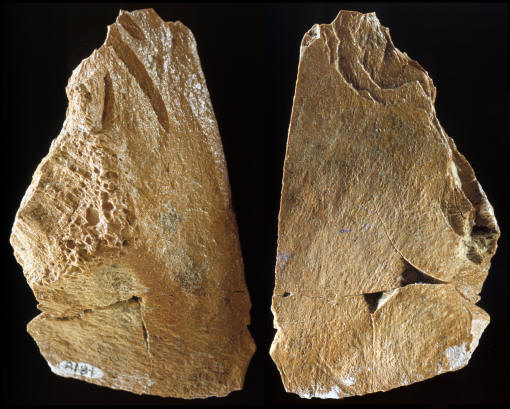
COLLECTION OF ARCHAEOLOGICAL
LABORATORY, CENTER FOR WESTERN STUDIES
AUGUSTANA COLLEGE
CLICK ON PICTURE FOR LARGER IMAGE
FLAKE CUTTING TOOL
MAMMOTH BONE
BONE FLAKE NO. 81-81
LANGE FERGUSON SITE
SOUTH DAKOTA
This bone flake is the best evidence of a mammoth bone tool
that was found on the Lange Ferguson site. It was used in the
butchering process of at least one of the Lange Ferguson mammoths.
It's described as a flake cutting tool. This tool was made from the
diaphyseal (midsection) segment of a mammoth long bone. What makes
it important is the fact that it was found tightly
wedged, in a vertical position, into the cartilage area of the thoracic
vertebra where it's believed it was being used to cut through connecting
tissues. SEM (scanning electron microscope)
analysis of the edge indicates that it was dulled from cutting
activities. |
|
|
The Lange Ferguson mammoth kill site is located in South Dakota.
The site is most famous for the stone tools and for the human-modified
bone artifacts that were found with the bones of two mammoths. Some of
the fractured bone is believed to show evidence of manufacturing
technology rather than accidental bone breakage caused by nature. The
excavation of the Lange Ferguson site produced several examples of fractured bones
in the form of cores, flakes and large pieces that seem to be technologically altered
by platform preparation and bifacial flaking. |
|

COLLECTION OF ARCHAEOLOGICAL
LABORATORY, CENTER FOR WESTERN STUDIES
AUGUSTANA COLLEGE
CLICK ON PICTURE FOR LARGE TRIPLE VIEW IMAGE
MAMMOTH BONE CHOPPER /
CLEAVER
CLEAVER NO. 81-22
LANGE FERGUSON SITE
SOUTH DAKOTA
This is the heavier and shorter of the two large chopper/cleavers
that were discovered on the Lange
Ferguson site. Both of the cleavers were made from the flat bone area from the same
right scapula of an adult mammoth. They provide some of the best
evidence of human-modified bone from the site. SEM (scanning electron microscope)
examination of the working edge surface of this cleaver (no. 81-22)
shows overlapping hinge fractures at the end of flake scars and
crushing. Both cleavers and two other scapula fragments were articulated
in such a way that it was possible to reconstruct their reduction (manufacturing)
process. Edge wear and flake removal patterns indicate the two cleavers were probably used in the butchering process of the
two mammoths. This cleaver measures 13 3/16 inches (33.5 cm) long
and weighs 13.4 pounds (6,088 grams). |
|
|
There is some disagreement among archaeologists concerning
bone-tool identification. Identifying a bone that was broken by natural
forces can be easily confused with a bone that was human-modified. Two
of the ways a bone can be broken naturally is by carnivore gnawing and
by trampling. Hyenas and lions can break apart the limb bones of animals
weighing over a ton (2204 kg). In fact, hyenas have been observed
levering and pulling off large flakes of bone measuring 11 3/4 inches
(30 cm) long and 3 7/8 inches (10 cm) wide from the limb bones of young
elephants. Proper identification of human-modified bone
artifacts depends heavily on good lab analysis. Key points of interest
will be edge wear, flake removal patterns, refitting of any
manufacturing debris, and artifact location. |
|
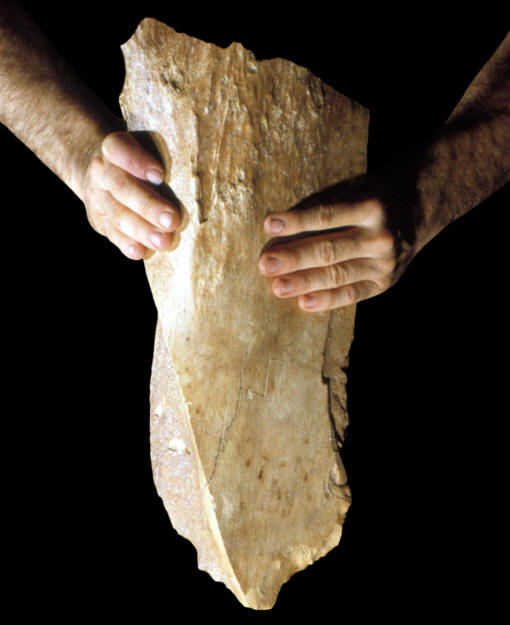
COLLECTION OF ARCHAEOLOGICAL LABORATORY, CENTER FOR WESTERN STUDIES
AUGUSTANA COLLEGE
CLICK ON PICTURE FOR LARGE TRIPLE VIEW IMAGE
MAMMOTH BONE CHOPPER / CLEAVER
CLEAVER NO. 81-32
LANGE FERGUSON SITE
SOUTH DAKOTA
This is the longest of the two cleavers that were discovered on the Lange
Ferguson site. Both cleavers were made from the flat bone area from the same
right scapula of an adult mammoth and they provide some of the best
evidence of human-modified bone from the site. Both cleavers are described as having some bifacial flaking.
A portion of the edge of this cleaver (no. 81-32) was
bifacially flaked into a sinuous edge. Both of the cleavers and two other
scapula fragments were articulated in such a way that it was possible to
reconstruct their reduction (manufacturing)
process. It's believed that this cleaver was used in the butchering process of the mammoths.
It measures 17 15/16 inches (45.5 cm) long and weighs 7.28 pounds
(3,302.7). |
|
|
Some of the Lange Ferguson mammoth bones have wear
patterns that suggest they were used in chopping, cutting or wedging
processes. A few of the bones also exhibit flake removal patterns that
seem to indicate they were purposely shaped to produce a tool. Both of
these observations plus the way in which some of the bones were
articulated suggest that some bones were deliberately modified and used
in the butchering process of the two mammoths. |
|
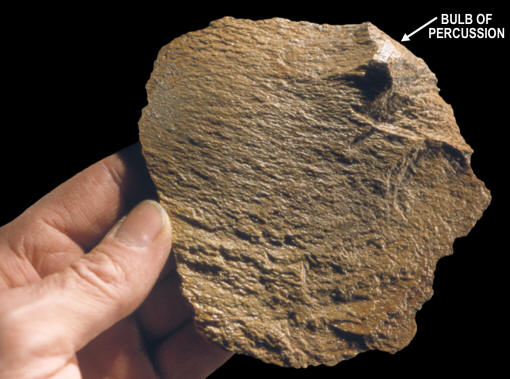
COLLECTION OF ARCHAEOLOGICAL
LABORATORY, CENTER FOR WESTERN STUDIES
AUGUSTANA COLLEGE
CLICK ON PICTURE FOR LARGE TRIPLE VIEW IMAGE
MAMMOTH BONE FLAKE
WITH BULB OF PERCUSSION
FLAKE NO. 81-303
LANGE FERGUSON SITE
SOUTH DAKOTA
This bone flake has one of the best examples of a bulb of
percussion. It was detached from a diaphyseal (midsection)
segment of the mammoth's tibia. It appears that it was hit or struck
fairly hard. It's described as having hackle marks or lines of force
that radiate away from the bulb of percussion. |
|
|
The best evidence of a mammoth bone tool used in the
butchering process of a mammoth is represented as specimen no. 81-81 and
described as a flake cutting tool. The tool was made from the diaphyseal
(midsection) segment of a mammoth long bone. It was found tightly
wedged, in a vertical position, into the cartilage area of the thoracic
vertebra where it's believed it was being used to cut connecting
tissues. SEM (scanning electron microscope)
analysis of the edge indicates that it was dulled from cutting
activities. |
|
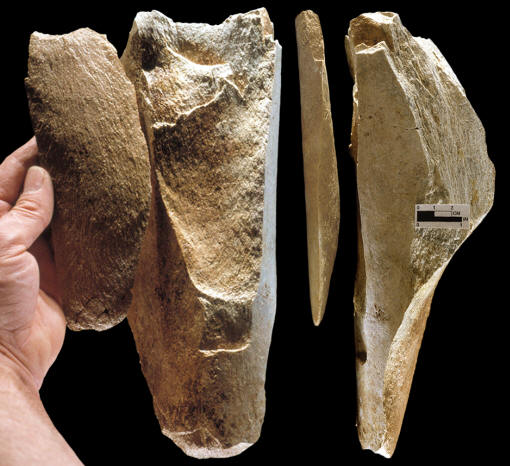
COLLECTION OF ARCHAEOLOGICAL LABORATORY, CENTER FOR WESTERN STUDIES
AUGUSTANA COLLEGE
CLICK ON PICTURE FOR LARGER IMAGE OF CORE
MAMMOTH BONE CORE & REFIT
FLAKE
CORE NO. 81-304 & FLAKE NO.
81-154
LANGE FERGUSON SITE
SOUTH DAKOTA
This picture shows two
different views of one of the five bone cores that were
identified on the Lange Ferguson site. This is one of the best examples
of a bone core that was found on the site. Both the core and a large
refit flake were recovered. This core shows evidence of platform
preparation prior to the longitudinal removal of the large flake.
The bone core was struck from the end to remove this flake. This
core measures 10 1/4 inches (26.1 cm) long and weighs 3.3 pounds
(1,452.9 grams). |
|
|
Two large chopper/cleavers were discovered on the Lange
Ferguson site. Both were made from the flat bone area from the same
right scapula of an adult mammoth. They provide some of the best
evidence of human-modified bone from the site. SEM (scanning electron microscope)
examination of the working edge surface of the heavier cleaver (no. 81-22)
shows overlapping hinge fractures at the end of flake scars and
crushing. Both cleavers are described as having some bifacial flaking. A
portion of the edge of the lighter and longer cleaver (no. 81-32) was
bifacially flaked into a sinuous edge. The cleavers and two other
scapula fragments were articulated in such a way that it was possible to
reconstruct their reduction (manufacturing) process. Both of these tools have been
determined to have been used in the butchering process of the mammoths. |
|

COLLECTION OF ARCHAEOLOGICAL LABORATORY, CENTER FOR WESTERN STUDIES
AUGUSTANA COLLEGE
CLICK ON PICTURE FOR LARGER IMAGE
MAMMOTH BONE FLAKE
FLAKE NO. 81-154
LANGE FERGUSON SITE
SOUTH DAKOTA
This bone flake was removed from a segment
of mammoth bone tibia. It's believed to have been deliberately
removed or struck from a mammoth bone core that shows
evidence of platform preparation. This flake
was removed longitudinal from the end of the core. It measures
approximately 6 7/8 inches (17.1 cm) long and 3 1/8 inches (8 cm)
wide. |
|
|
Five bone cores were
identified on the Lange Ferguson site. One of the best examples (no.
81-304) shows evidence of platform
preparation prior to the removal of a large flake (no.
81-154). Both the core and refit
flake were recovered. The flake was removed longitudinally. |
|
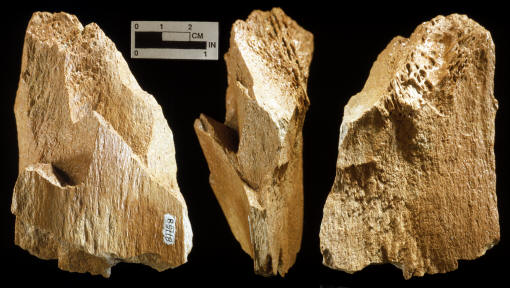
COLLECTION OF ARCHAEOLOGICAL
LABORATORY, CENTER FOR WESTERN STUDIES
AUGUSTANA COLLEGE
CLICK ON PICTURE FOR LARGER IMAGE
MAMMOTH BONE CORE
CORE NO. 81-158
LANGE FERGUSON SITE
SOUTH DAKOTA
This
picture shows one of the five identified mammoth bone cores that were
found on the Lange Ferguson site. It is a diaphyseal (midsection)
fragment of a mammoth long bone. This core is described as having negative
scars on both surfaces with four negative scars on the distal
surface parallel to the longitudinal axis. One side has a remnant
portion of a bulb of percussion and lines of force. This bone core
measures 4 1/16 inches (10.4 cm) long and it weighs 1/3 of a pound
(145 grams). |
|
|
One of the best examples
of a bulb of percussion can be seen on bone flake number 81-303. This
flake was detached from a diaphyseal (midsection)
segment of the mammoth's tibia. It appears that it was hit or struck
fairly hard. There are also hackle marks or lines of force that radiate
away from the bulb of percussion. |
|
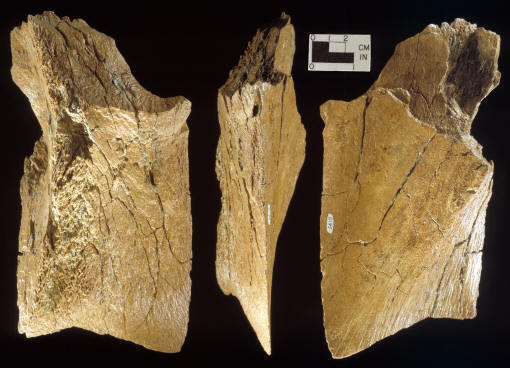
COLLECTION OF ARCHAEOLOGICAL
LABORATORY, CENTER FOR WESTERN STUDIES
AUGUSTANA COLLEGE
CLICK ON PICTURE FOR LARGER IMAGE
MIDSECTION MAMMOTH BONE
FRAGMENT
BONE NO. 81-75
LANGE FERGUSON SITE
SOUTH DAKOTA
This
bone is a portion of a diaphyseal (midsection)
of a mammoth long bone. Its main feature of interest is the
wear-fracturing on one end (proximal
end). Both edges
of one end was altered by heavy pressure or "points of loading" that
fractured away much of the bone. This bone measures 8 7/8 inches
(22.5 cm) long and weighs 1.33 pounds (606.7 grams). |
|
|
There were a total of
four stone artifacts found on the Lange Ferguson site. Two complete
fluted Clovis points and the broken base of another were found within
the excavation area. The fluted points were laying on the bank of an
ancient pond. A single flake made of semi-translucent brown chalcedony
was also found in direct association with the mammoth bones in the
central bone bed concentration. It's believed that the flake was removed
from a biface. |
|
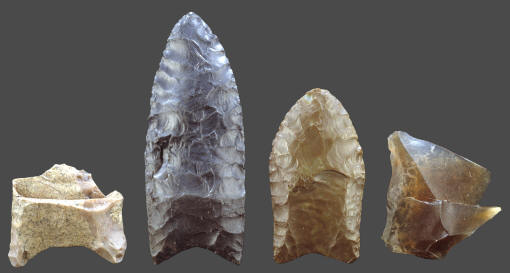
COLLECTION OF ARCHAEOLOGICAL
LABORATORY, CENTER FOR WESTERN STUDIES
AUGUSTANA COLLEGE
CLICK ON PICTURE FOR LARGER IMAGE
CLOVIS POINTS AND FLAKE
LANGE FERGUSON SITE
SOUTH DAKOTA
This picture shows all
four of the stone artifacts that were found during the excavation of the Lange Ferguson site.
The two complete
fluted Clovis points and the broken base of another were found within
the excavation area. The fluted points were laying on the bank of an
ancient pond. The longest point is made of black opaque chert and
measures 2 1/8 inches (54 mm) long. The flake, at right, is made of semi-translucent brown
chalcedony and it was found in direct association with the mammoth bones in the
central bone bed concentration. It's believed that the flake was removed
from a biface. |
|
|
The Lange Ferguson
mammoth kill site ranks as one of the most important
Clovis sites ever discovered. The mammoth bone butchering tools that
were found there, with "obvious" use wear and
manufacturing technology, are extremely rare and almost unique in North
America. Lange Ferguson provided an extraordinary look into the lives of an ancient nomadic
culture who were taking advantage of a natural food resource just as
hunters and fishermen still do today. |
|
"REFERENCES"
1912, Hodge, Frederick Webb,
"Bone-Work," Handbook Of American Indians North Of Mexico,
Part 1.
1989, Hannus, L. Adrien, "Flaked Mammoth Bone From The Lange
Ferguson Site White River Badlands Area, South Dakota," Bone Modification,
1990, Hannus, L. Adrien, "The Lange Ferguson Site: A Case For
Mammoth Bone-Butchering Tools," Megafauna & Man, Scientific Papers, Vol. 1,
2001,
Blackwell, Lucinda R., d'Errico, Francesco, "Evidence of termite
foraging by Swartkrans early hominids," Proceedings of the National
Academy of Sciences, January 16, 2001.
2002, Haynes, Gary, "The Early Settlement Of North America,"
2005, Holen, Steven R., "Taphonomy Of Two Last Glacial Maximum Mammoth
Sites In The Central Great Plains Of North America: A Preliminary Report
On La Sena And Lovewell,"
Personal Communication with Adrien Hannus, Archaeological
Laboratory, Center For Western Studies Augustana College.
|
|
RECENT
LISTINGS HOME
ORDERING |